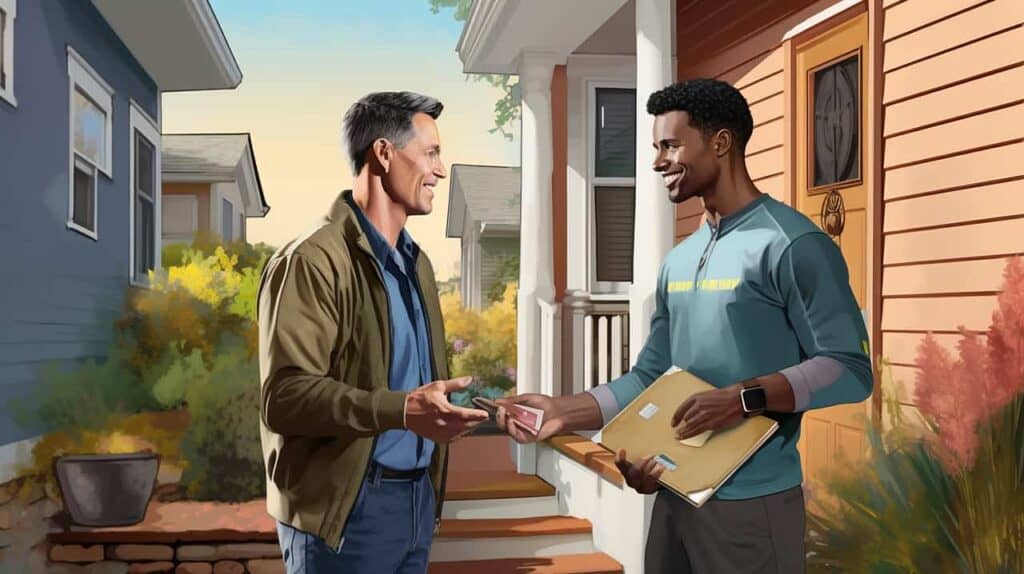As a seasoned door-to-door salesperson, I’ve learned that 95% of customers prefer face-to-face interactions when making purchasing decisions.
That’s why I’ve created this comprehensive guide to help you excel in the world of door-to-door sales. From perfecting your sales pitch to overcoming objections, I’ll share my knowledge and experience to ensure your success.
Whether you’re a seasoned pro or new to the field, this guide will provide you with the tools and strategies you need to thrive in this dynamic industry.
Key Takeaways
Door-to-door sales allow for direct interaction with potential customers, building relationships and providing a firsthand experience of the product or service.
The role of a door-to-door salesman has expanded beyond knocking on doors, now including strategies like telemarketing.
Successful door-to-door sales involve practicing and perfecting the sales pitch, adapting to individual scenarios, and being prepared to overcome objections.
Building a personal connection with prospects and understanding them on a deeper level increases the chances of closing a deal.
Table of Contents
The Importance of Product Knowledge in Door-to-Door Sales

Product knowledge is crucial for success in d2d sales Danny Pessy. As a door-to-door salesperson, I understand the importance of being knowledgeable about the products I’m selling, such as solar panels. Having in-depth knowledge allows me to confidently address any questions or concerns that potential customers may have. It also enables me to highlight the benefits and features of the product, giving customers a clear understanding of how installing solar panels can benefit them.
By demonstrating my expertise, I establish trust and credibility with customers, increasing the likelihood of making a sale. Additionally, staying up-to-date with solar sales training and industry trends further enhances my product knowledge and positions me as a reliable and informed sales professional.

With comprehensive product knowledge, I’m able to deliver persuasive pitches and effectively meet the needs of my customers in the ever-changing world of door-to-door sales.
Adapting Door-to-Door Sales Techniques for Modern Times

Adapting door-to-door sales techniques for modern times involves utilizing digital marketing strategies and incorporating technology into the sales process. In today’s fast-paced digital age, it is essential for door-to-door salespeople to adapt their approach to reach a wider audience and stay ahead of the competition. By leveraging digital marketing strategies, such as social media advertising and email campaigns, salespeople can expand their reach and engage with potential customers even before knocking on their doors. Incorporating technology, such as mobile apps and CRM systems, allows for efficient lead management and personalized interactions. To further engage the audience, here is a table showcasing the key elements of adapting door-to-door sales techniques for modern times:
| Elements | Description | Benefits |
|---|---|---|
| Digital Marketing Strategies | Utilize social media and email campaigns | Reach a wider audience |
| Technology Integration | Incorporate mobile apps and CRM systems | Streamline lead management and personalization |
| Personalized Interactions | Tailor the sales pitch to individual customers | Increase the chances of closing a deal |
Key Strategies for a Successful Door-to-Door Sales Pitch

My key strategy for a successful door-to-door sales pitch is to establish rapport with the prospect from the start. Building a connection and establishing trust is crucial in gaining control of the sales conversation.
To achieve this, I focus on active listening and showing genuine interest in the prospect’s needs and concerns. By demonstrating empathy and understanding, I can address their pain points effectively and offer tailored solutions.
Additionally, I utilize persuasive techniques such as storytelling and social proof to demonstrate the value and reliability of the product or service. By presenting myself as a knowledgeable and trustworthy salesperson, I can instill confidence in the prospect and increase the likelihood of a successful sales pitch.
It’s important to remember that control in the sales process comes from building relationships and understanding the prospect’s motivations and desires.
The Power of Practice and Shadowing in Door-to-Door Sales

Through consistent practice and by shadowing experienced salespeople, I’ve learned the power of honing my skills and observing effective techniques in door-to-door sales. This combination has been instrumental in my success as a door-to-door salesperson.
Here are three key takeaways from my experience:
- Increased Confidence: Practicing my sales pitch repeatedly has boosted my confidence when approaching potential customers. The more I practice, the more comfortable and persuasive I become in delivering my message.
- Learning From the Best: Shadowing experienced salespeople has allowed me to observe their techniques and learn from their successes. I take notes and apply their strategies to my own sales approach, resulting in better outcomes.
- Adaptability: Through practice and shadowing, I’ve learned the importance of being flexible and adaptable in my sales approach. Not every customer is the same, and being able to adjust my pitch to the specific needs and preferences of each individual has significantly increased my sales conversion rate.
The Art of Direct Communication in Door-to-Door Sales

Connecting with prospects and being direct in my communication are key elements of successful door-to-door sales. In order to effectively engage with potential customers, I utilize the art of direct communication. This approach allows me to clearly convey the value of the product or service I am offering, while respecting the prospect’s time. By being direct and concise, I make it easier for them to understand the benefits and make an informed decision. To illustrate the importance of direct communication in door-to-door sales, I have created a table showcasing the advantages it brings:
| Advantages of Direct Communication |
|---|
| Builds trust and credibility |
| Saves time for both parties |
| Enhances the customer’s decision-making process |
| Demonstrates respect for the prospect’s time |
| Allows for clear and concise information delivery |
Building Personal Connections in Door-to-Door Sales

To foster personal connections in door-to-door sales, I engage with potential customers on an individual level and establish rapport. Building personal connections is essential in creating trust and increasing the chances of closing a sale.
Here are three effective strategies for building personal connections in door-to-door sales:
- Active Listening: I actively listen to the needs and concerns of potential customers. This shows that I value their opinions and genuinely care about their needs.
- Empathy: By putting myself in the shoes of the customer, I can better understand their perspective and tailor my approach accordingly. This helps me connect with them on a deeper level.
- Authenticity: I strive to be genuine and authentic in my interactions. People appreciate honesty and are more likely to trust and connect with someone who’s authentic.
Overcoming Objections: A Guide for Door-to-Door Salespeople

As a door-to-door salesperson, I’ve learned effective strategies for overcoming objections and successfully closing sales. When faced with objections, it’s crucial to remain calm, confident, and knowledgeable about the product or service being offered.
One strategy I employ is active listening. By truly understanding the prospect’s concerns, I can address them directly and provide tailored solutions.
Additionally, I use social proof to build credibility and trust. Sharing success stories and testimonials from satisfied customers helps alleviate doubts and objections.
Another powerful technique is reframing objections as opportunities. Instead of seeing objections as roadblocks, I view them as chances to provide further information and clarify any misunderstandings.

